Every year we ask installers in the SolarQuotes network which batteries they would trust in their own family homes. We ask two questions to tease out the best batteries in Australia for both big-spenders and the budget conscious.
- Which brand would you install on your own home if money was no object?
- Which brand would you put on your own home if money was tight and every dollar counts?
In 2023 we added a third question:
- Which battery brand offers the best after-sales support?
Interestingly, the same three brands took the podium for all 3 categories – just in a different order.
Here are the results:
Best Home Batteries In Australia 2023
Best Batteries 2023 Winner: Tesla
Tesla wins for a third straight year with the Powerwall. Tesla Powerwall 2 is a brilliant home battery with 13.2 kWh of storage in a sleek, compact housing and a built-in battery inverter that will AC couple as a retrofit to almost any grid-connected solar power system in Australia.
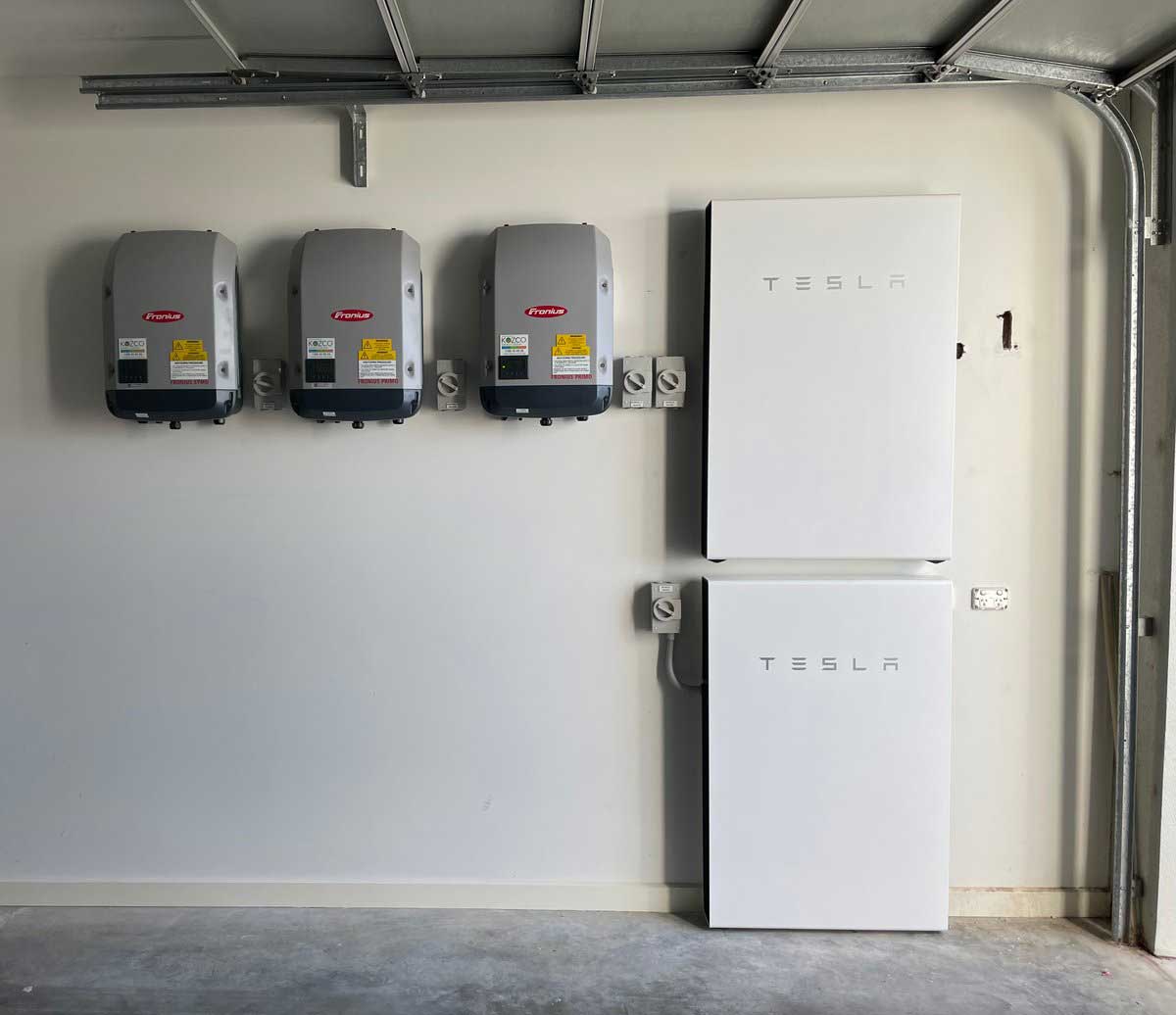
The second Powerwall will be thousands cheaper than the first because you only need one ‘gateway’ control box. Installation credit: Kozco
Tesla’s monitoring app is a joy to use, and the optional time-based control algorithm maximises battery savings on a time-of-use tariff and works brilliantly.
The Powerwall’s home backup just works and sets the standard for all other battery and battery inverters.
Surprisingly, Tesla’s share of ‘best battery’ votes has declined over the three years we’ve run this survey.
I suspect this is due to some installers frustrated with Tesla raising the price over those 3 years. Elon Musk morphing into a complete wazzock over this time probably doesn’t help, either.
Happily for Australian buyers, the cost of Powerwall may have peaked. With last week’s price cut, you can fully install your first Powerwall from about $16,500.
I suspect Tesla will find ways to keep reducing the Powerwall’s price, and I expect a step change in price with the Powerwall 31. If Tesla can manage to build a Gen 3 Powerwall that beats other batteries on $-per-kWh, they are going to fly off the shelves even faster than they do now2. Other home battery manufacturers should be worried.
Best Batteries 2023: Second Place – BYD
BYD’s stackable, cobalt-free LiFePo4 ‘B-Box’ is a great home battery and is directly compatible with the fantastic Fronius GEN24 hybrid inverter via DC coupling.
BYD batteries start at 5.1 kWh and go up to 66.2 kWh. Expect to pay about the same as a Tesla Powerwall per kWh if you are adding to an existing Fronius GEN24 powered system, and more if you need to buy a separate battery inverter.
Because BYD batteries require a third-party battery inverter, any functionality in terms of backup, tariff optimisation and monitoring software comes down to the inverter manufacturer or third-party monitoring/control app.
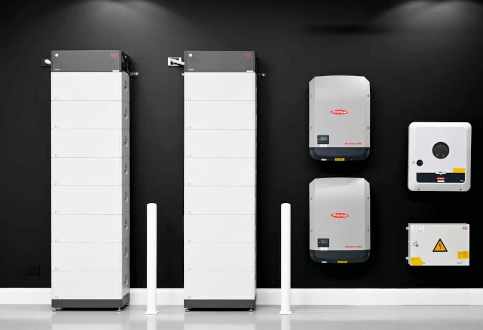
44.2 kWh of BYD B-Box Batteries: Installation Credit: Bluegum Electrical
Best Batteries 2023: Third Place – Sungrow
Giant Chinese inverter manufacturer Sungrow recently released their home battery solution in Australia and it’s been a hit. The stackable energy storage solution starts at 9.6 kWh and can be expanded with 3.2 kWh modules. You’ll need a Sungrow inverter to control the battery and can choose AC or DC coupling.
A 12.8 kWh Sungrow battery and Sungrow battery inverter retrofitted to an existing solar system starts at about $14,000 installed at the time of writing.
Sungrow has a great reputation for good value, well-supported hardware and is a great choice if you want to save a few thousand dollars over a Tesla.
I’m getting a Sungrow battery retrofitted to a 6.6 kW system this month. I’ve decided to replace the existing Fronius solar inverter3 with a Sungrow hybrid, so I can get some good personal experience with Sungrow hardware4.
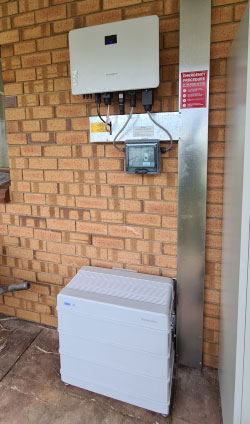
9.6 kWh of Sungrow battery with a Sungrow inverter
Best Value Home Batteries In Australia 2023
The ‘best value batteries’ podium contains all the ‘best’ winners but in reverse order. It shows how cautious good installers are around battery brands, mostly sticking with the same three even if asked to quote a budget solution.
Batteries: Best After-Sales Support
Lithium-ion home batteries have only been installed in Australia in any volume since 2015. It’s a relatively new market, and good, dedicated, well-resourced Australian support is critical.
Here are the battery brands with the best support:
Knock me down with a feather – it’s the same 3 brands!
Tesla has great support for their battery. They can diagnose most issues remotely, and I’m hearing good things about their warranty support (after a shaky start a few years ago).
For a ‘budget’ brand, Sungrow also gets big props for their helpful Australian support that is better than many ‘premium’ battery brands’ support efforts.
It’s good to see BYD doing well with their Aussie home battery support – bear in mind that if you need help with your BYD you may also need to deal with the battery inverter vendors’ support.
Conclusion
At the end of the day – if you are looking for a low-risk home battery, the message from the 2023 installer survey is clear:
- Retrofitting a battery and want the best? Get a Tesla Powerwall.
- Already got a BYD-compatible hybrid inverter, and want a battery? Get a BYD.
- Want to spend about 20% less than a Tesla? Get a Sungrow battery and Sungrow hybrid inverter – either retrofitted or as part of a new solar installation.
See all SQ recommended solar battery brands here.
Also check out more from the SolarQuotes Installers’ Choice Awards 2023 – Best Solar Panels | Best Solar Inverters | Best Home EV Chargers.
Footnotes
- Which won’t be called Powerwall 3 ↩
- I also expect the Gen 3 Powerwall to have at least 4 MPPTs with wide current and voltage windows, making it compatible with almost any residential roof, and removing the cost of a separate solar inverter ↩
- Mainly to wind Anthony up TBH. ↩
- SolarQuotes does not accept free review hardware from manufacturers – because they invariably then think they can influence your editorial. At SolarQuotes we are very wary of big corporates. ↩

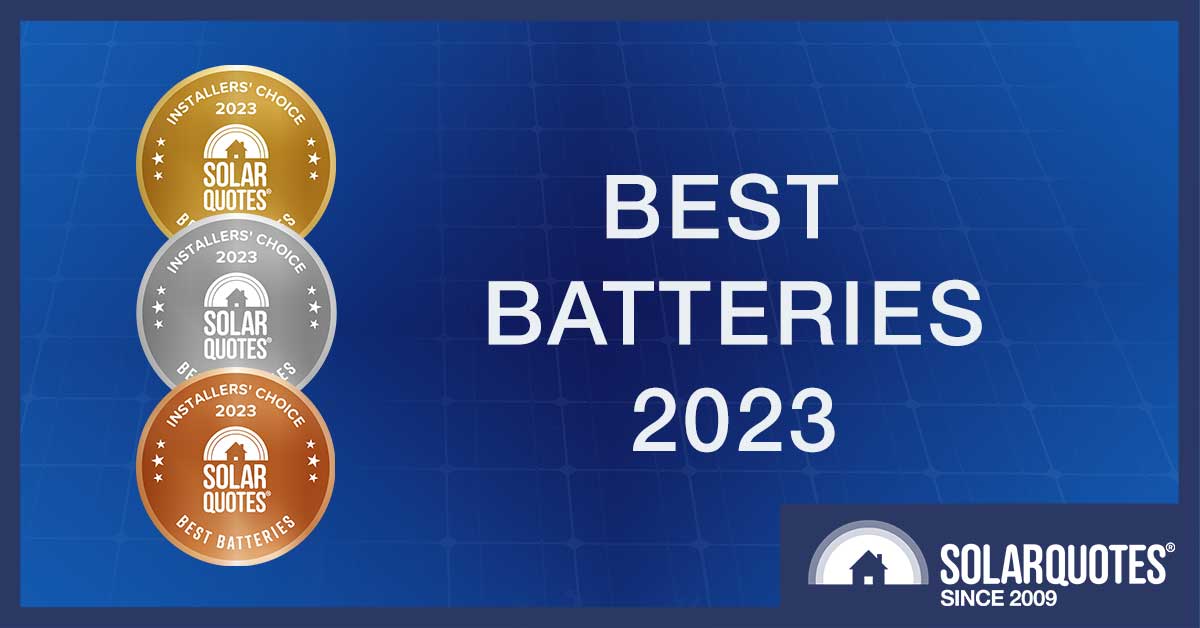
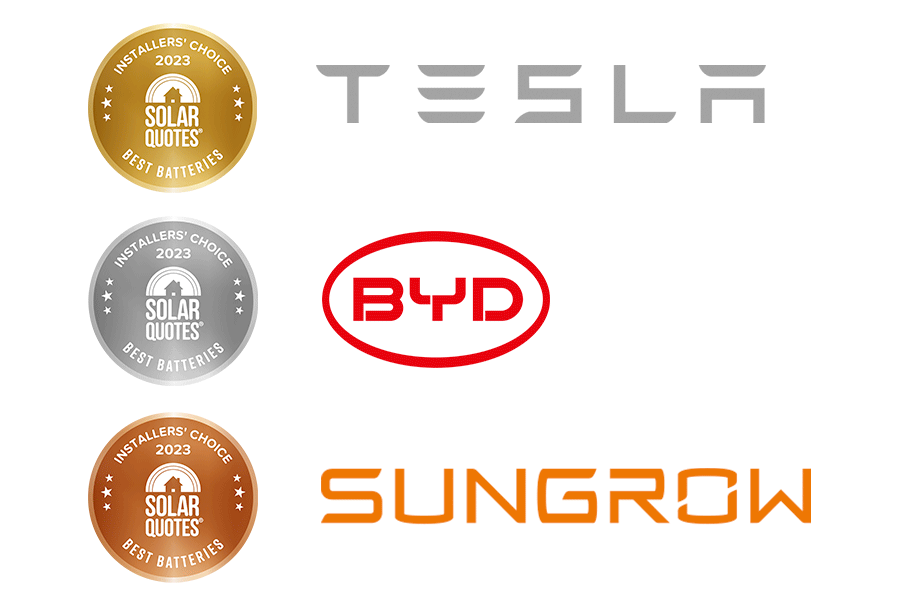
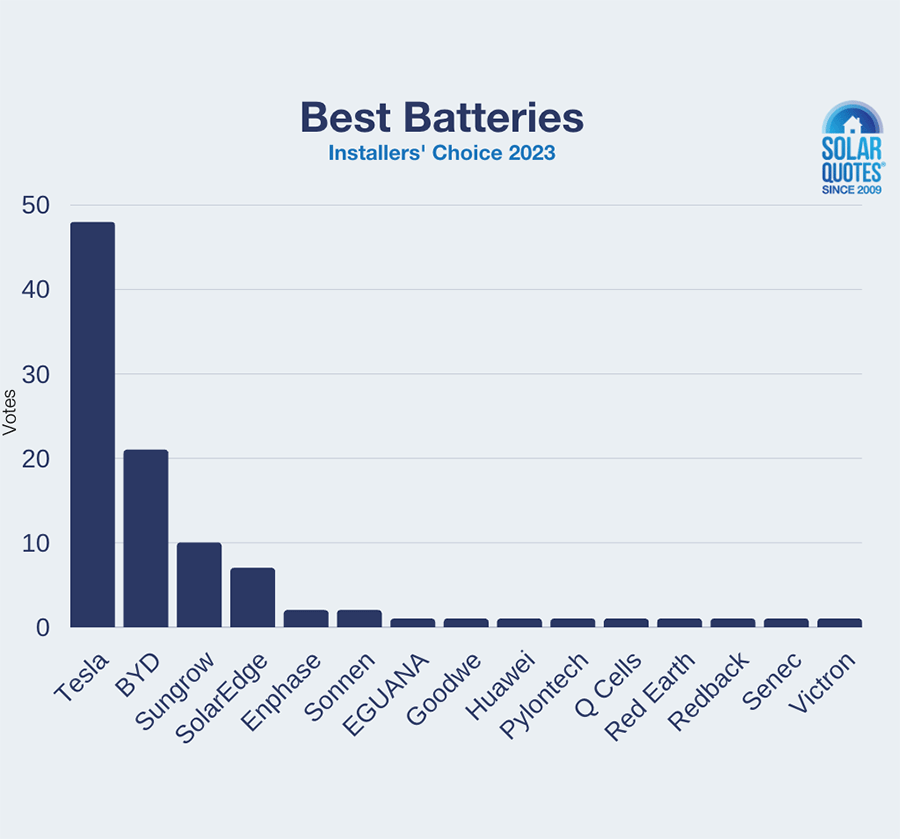
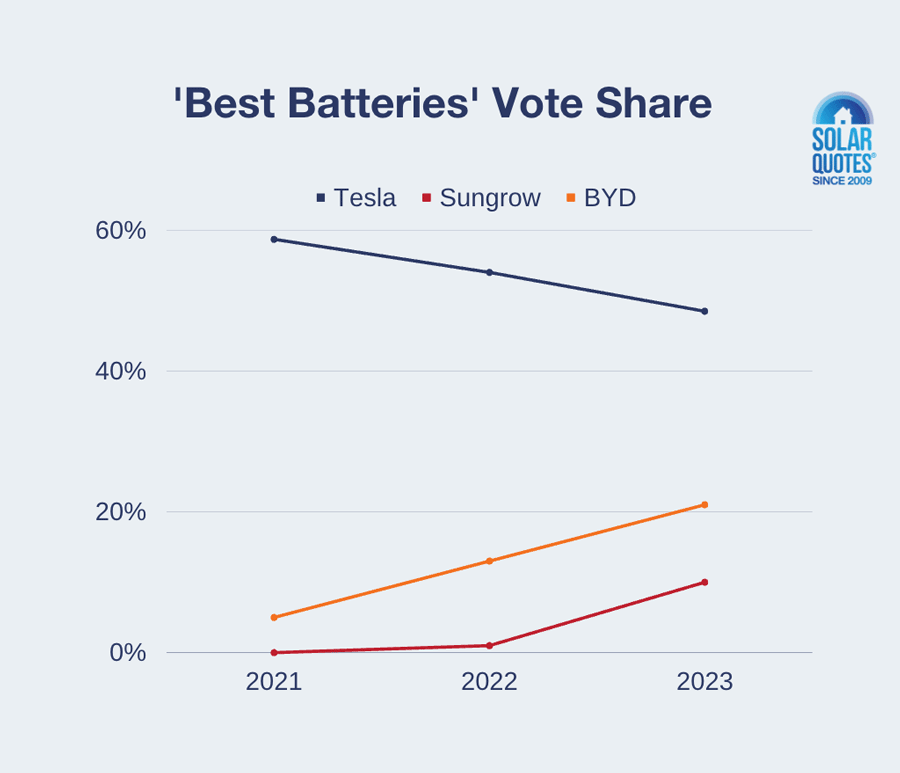
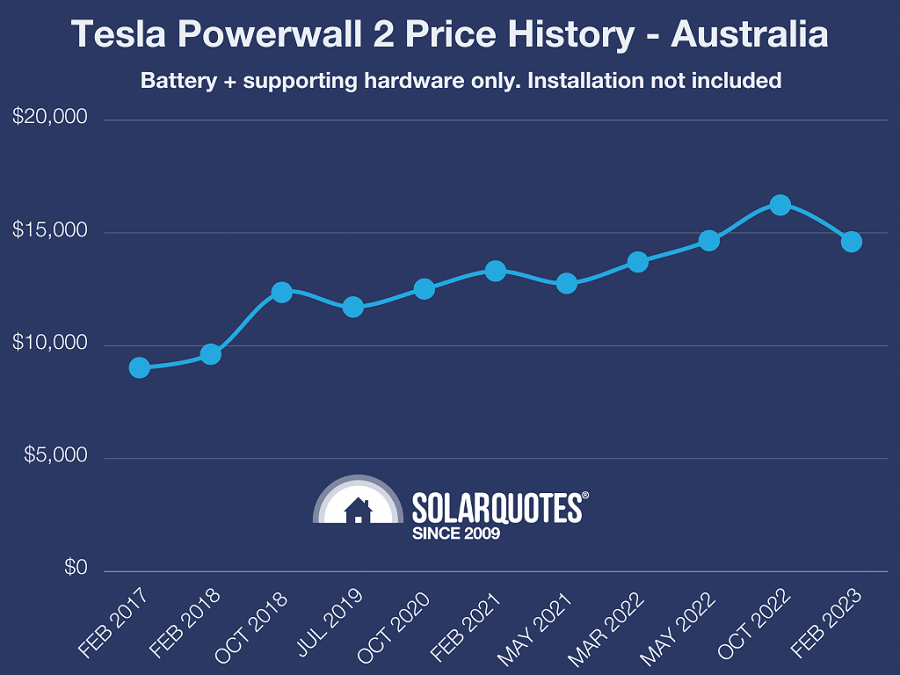
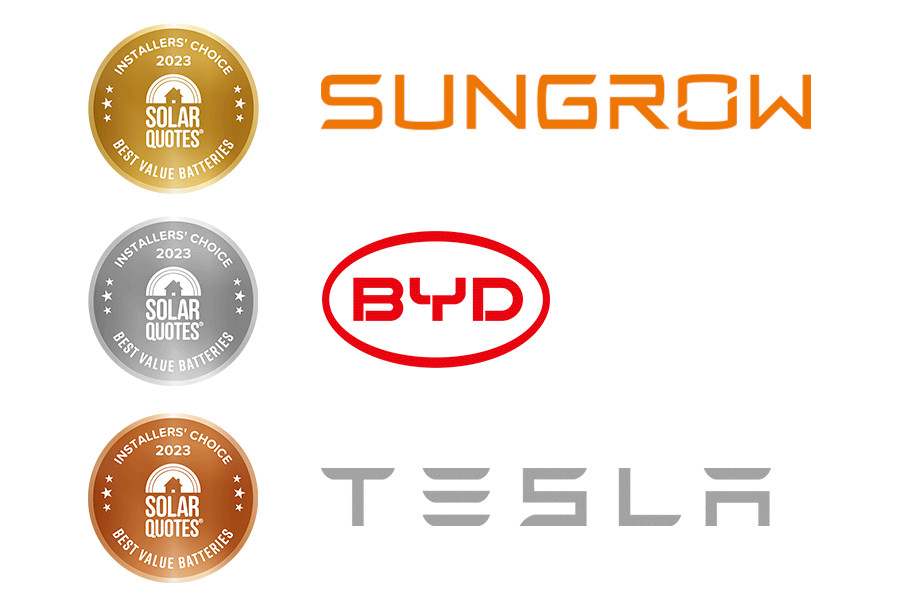
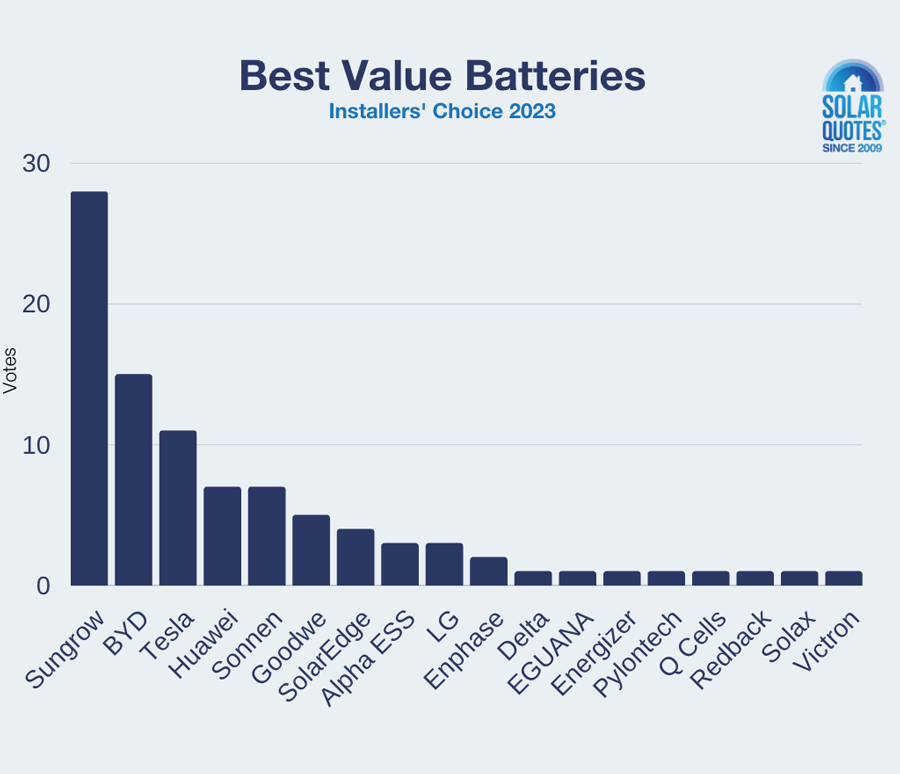
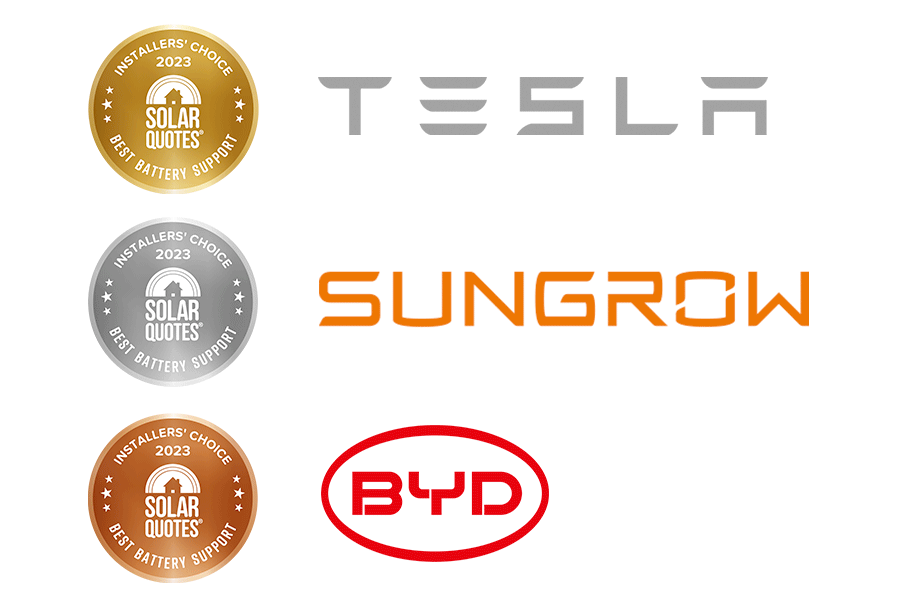
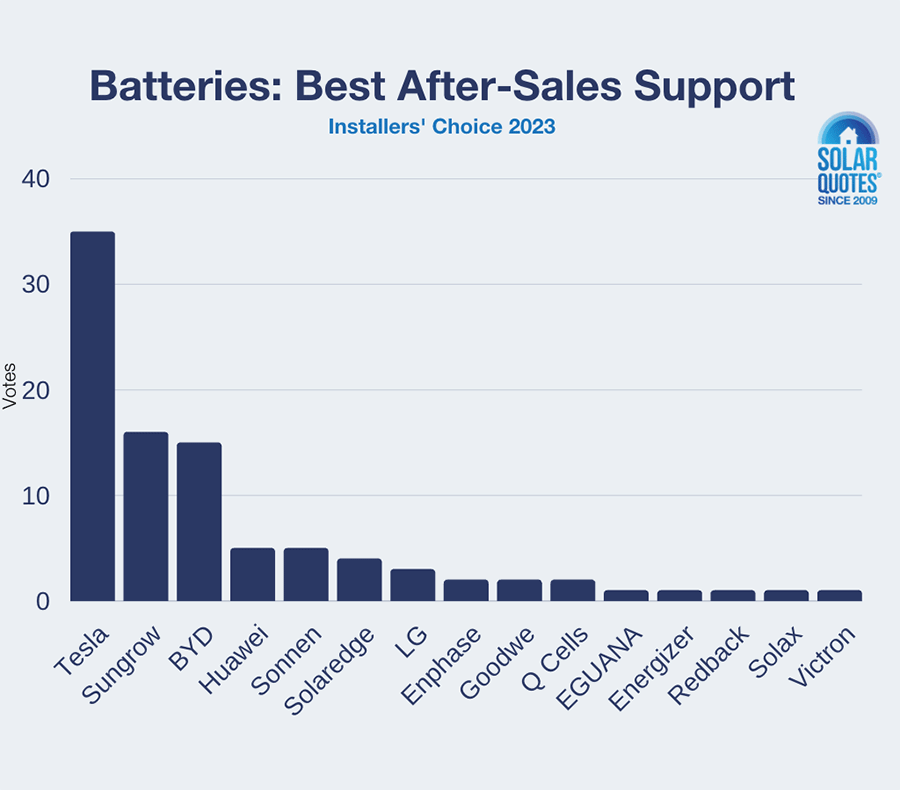
 RSS - Posts
RSS - Posts



How is Alpha Ess not on this list?
Quite simply because the installers didn’t vote for it.
Can you confirm it was on the list? I would be really surprised because I haven’t heard of any issues and I am on quite a few Facebook groups, and quite a few companies install them in Australia. Mine has been amazing since day 1 and had it over a year now.
There is no list. The questions asked were open to any answer.
Look at the ‘best value batteries’ chart. Alpha ESS got 3 votes.
Hi Finn
Please Wd you go for sungrow and sungrow battery3 phase
Or sungrow and Tesla battery
And ja JAM54D40-440/LB/1500V JA Solar N-TYPE panels
I want to buy Tesla battery to my home,
I’m Sunshine Coast and kindly recommend me any installer in SC.
Regards.
John
https://halcolenergy.com.au/tesla-powerwall-2/
Good to know. Mine is 14 months old and seems to be doing its job nicely too.
I have been living in the Daintree for the last 30 years. The only place in mainland Australia where the supply of grid power was barred by an act of political Bastardry. We have been forced to live on solar and batteries. And if you want to what’s the best ask the people in the Daintree. I myself have opened for Nickel / Iron batteries. Yes google em under Eddison Batteries. Why ? Because you only have to buy them once. They don’t wear out. The fluid inside them is a metal preservative, not an acid. You can flatten them out to 19 volts in a 24 volt system and float them up to 35 volts every day and they love it. Do that to a Tesla or a Gelcell and you will kill it in a week. They like to work between23 volts and 28 volts yes 5 volts of usable power from 24 volts. I am using 16 volts from 24 Done ya sums yet??
Hi Bob,
It was a surprise to find NiFe batteries still sold today. I’ve forgotten most of what I picked up when looking at them, but recall that their efficiency is very high if charged only to ~ 80% capacity. After that it dwindles toward 50%, and electrolysis dissipates the water. I also made a note that they have high internal resistance, so you need a larger bank to supply surges and avoid
inverter cutoffs from voltage sag. (I need to start a 2 kW induction motor on a compressor, maybe 10 kW peak?)
Have you found the distilled water use to be “Around 1 mL/Ah/month at 1.6v/cell charging voltage. That’s 8L/month for 40 200 Ah cells.”?
And perhaps “Charging efficiency drops rapidly above 30°C, so cooling may be required to remove charging heat.”?
Their robustness and limited discharge rate seem similar to Redflow’s ZnBr flow batteries,but without all the pumps ‘n stuff. And cheaper. But not cheaper than LiFePO4. Incidentally, how long have you had yours?
It is worth remembering that that 5v droop between charging and discharging is lost energy. You only get the AH back, so a LiFePO4 battery, with a wonderfully flat voltage plot on discharge is showing significantly higher cycle efficiency. (For less lifetime years, I’m forced to admit.) If you have an ample PV array, an amply sized battery, and Queensland sunshine, It’s only a heat buildup issue, probably insignificant, I figure.
I’m also too vague on the (CO2?) electrolyte poisoning issue, potentially requiring electrolyte replacement after 5 – 10 years? (Has to be cheaper than new batteries, in any case.)
So as you can see, not entirely won over by this interesting technology.
Alpha Ess all the way. I had a fault, after sales warranty support fantastic. 26.6kw far cheaper than Tesla. Tesla do have some advantages but you pay a lot more also.
I tend to agree. There’s an inherent self-fulfilling prophecy in asking installers who they prefer.
Also, there’s no guarantee installer votes aren’t influenced by kick backs from manufacturers etc…
Personally I think solar quotes is best to stick with their own unbiased reviews of hardware and software solutions, which happen to be excellent for that exact reason.
In any event, there appears to be some truth to the after sales support survey….After reading this post (https://www.solarquotes.com.au/blog/alphaess-battery-warranty/) about Judy having Warranty issues with Alpha ESS.
I sent an email this time last week to their [email protected] address asking after their EV charger and yet to hear anything back. And the fact they don’t have a dedicated AU website (but an NZ site) is a little odd…
Sungrow on the other hand, answered my email within a few hours.
Seems very targeted at single phase homes? AC coupled really doesn’t work that well for three phase, so Tesla’s out straight away. The fact that they also use a cathode chemistry that runs the risk of thermal runaway as opposed to BYD and Sungrow, does make me wonder how these are actually judged? AFAIK Fronius take up to 90 seconds to switch over in the event of a mains failure, whereas Sungrow is seamless, which would surely be a key consideration when looking into batteries? This leaves me very confused as to what these are actually being judged on…
“how these are actually judged?”
There are no judges. It’s a survey.
The questions are carefully worded and self-explanatory, and answered by the guys that have the most experience with battery brands, the installers:
Which brand would you install on your own home if money was no object?
Which brand would you put on your own home if money was tight and every dollar counts?
Which battery brand offers the best after-sales support?
Is there a significant difference between single and triple phase households?
Is there a significant difference between batteries as your primary source before relying on grid, and batteries with offgrid capability?
Or is this really not a battery issue (so not relevant to this survey) and more an inverter matter? I periodically glance at the cost-benefit situation (power’s still too cheap to justify an on-grid battery system) but haven’t done a deep dive into understanding battery requirements for a 3 phase home so plead to near total ignorance on the matter.
https://www.solarquotes.com.au/blog/home-batteries-3-phase/
Thanks.
Downthread you mention the Fronius Symo is a 3 phase that will work with a Powerwall but not in backup mode which I presume you mean as off-grid.
Is that true for other 3 phase systems like the SMA Sunny Tripower? Do most 3 phase solar inverters currently sold in Australia simply not support temporary off-grid operations? The table off your original link suggest this is the case – (https://www.solarquotes.com.au/battery-storage/hybrid-inverter-comparison/). A quick Duck suggests there are solar inverters out that support battery functions e.g. the Fronius Gen 24, the (new?) Sunny Tripower etc, so is it simply that these still aren’t available in Australia?
I’ll likely talk to my solar installer next financial year (once power prices have changed) to check what my options are but it’s looking like rock v hard place.
There are many 3-phase hybrid, solar, grid-connect inverters that will provide 3-phase backup without the grid, such as the 3-phase Gen 24 and Sungrow. Just check the current limitations the inverter puts on the backed up circuits.
Fronius is a seamless changeover in the event of a power failure as well with us having gone through 26 events totalling 4hrs all up, our longest was 2hrs, and yet there has only been a handful of those 26 times where the most we have noticed was a slight flicker of a lightbulb. And even then we’ve had to verify the fact with whoever is present at the time as in asking ‘did that light just flicker or am I imagining things?’.
To highlight things even more, the number of times that I’ve gone poking around in the Tesla app only to come across the backup info and discover that we had an outage recently at some stage yet no one here knew anything about it until I found that info all well and truly after the fact and everything being back up and running as one would expect.
Thread drift….
Tesla cars will have bi-directional charging from 2025.
(a seldom mentioned announcement at their planning presentation)
Tesla home battery will AC couple with any existing solar system? I’ve looked but Fronius Primo doesn’t appear to work with a battery.
A Tesla Powerwall will work with a Fronius Primo.
This I can certainly confirm as I am running a Fronius Primo Inverter with a Tesla Powerwall Battery and have been since October 2020 after having my Solar initially installed in November 2017. I also have not had to pay a power bill since having the battery installed with my electricity account being currently along way in credit and that’s after almost $1000 worth of credits being utilised to pay my gas account at the time.
Very happy overall indeed, especially given that my electricity bills were consistently round $1200+/quarter back in the 2010-2017 days, my investment in solar and now battery has definitely paid for itself already, hands down.
Fronius symo too?
A Fronius Symo is a 3-phase inverter. Powerwall will work with a 3-phase solar inverter, such as a Symo
It will backup on one-phase, maximise self-consumption on your bill across all the phases (requires 3 phase utility meter).
But the solar will not work in backup mode.
Also if you have export limiting, it needs to be configured carefully across the phases.
If you want a Powerwall and your solar to work during backup on a 3-phase supply, then use 3 x single phase inverters or microinverters.
Two sons have had Tesla Powerwalls for about three years and both literally couldn’t be any happier with them.
I have the password details for both of them and can log in remotely on my phone to have a look which is great. Yes, it’s a shame they went way up in price but I suspect that’s a case of supply and demand.
(If you can get $XXX dollars for them and sell all you can make, why wouldn’t you?)
I’m just hoping they bring them out soon in LFP and hopefully cheaper, and then I’ll buy one too! It’s not really justified on pure economics, but as the grid transition occurs I strongly suspect it will become less reliable, so it will be a very “NICE” to have.
I also know the guy with the very first fully off grid system in Oz using Tesla Powerwalls- he has two. It was significantly cheaper for him than paying for a grid connection.
He’s equally delighted with his Powerwalls and the support that he’s had from Tesla.
Please , Approx how much for a second Powerwall 2 battery with latest pricing
You’ll save about $2,000 on the second Powerwall, so about $14,500
You are way off the mark with the comment about BYD pricing (thousands). I would recommend reaching out to a BYD distributor for updated pricing. BYD is much cheaper than Tesla.
I was quoted to have my gateway replaced to accommodate a 2nd Powerwall2. So actually more cost than installing the initial single Powerwall2 (relatively)
You have the OG gateway? Grey box?
OK, that’s the installers’ perspective. An AC coupled battery like the Powerwall is a quick and easy install / retrofit. Add a solid price, allowing adequate margin to keep the business ticking over, and you’re on a winner. It looks like a good enough fit while staying on grid, I’ll freely admit.
With grid independence in mind, my brother elected to go with a “wide mouthed frog”, the Zenaji Aeon LTO bateries, $30k worth of ’em. They’re warranted for 20,000 cycles, but it is the high charge/discharge rates which allow a 15.2 kWh bank to swallow the output of the 20 kWp arrays, and recover from a deep overnight discharge to full bank by 9 a.m., and then export 70 or 80 kWh later in the day. After dusk, they power an electric stove as well as a bunch of fridges & freezers without grid support. (2 battery inverters)
Going fully off-grid, I’m looking for a larger capacity, so cheaper per kWh LiFePO4 alternative, maybe Pylontech? They’re rated for 6000 cycles @ 90% DoD @ 25C; 10 yr warranty, yet much cheaper than Tesla, etc.
For owners, the equation is kWh * warranted_cycles / price, not installer convenience and profit. (Their aversion to being called back does though protect us against the shonkiest stuff.) A table of the equation’s parameters across products would be very nifty, but they change with time, so DIY research is doubtless the order of the day.
Battery reporting, via CAN or RS485, is also valuable, as unmanaged batteries can surprise alarmingly. Most important for my off-grid is something like Victron’s DVCC mode which dynamically manages energy flow, so AC loads can receive high DC power concurrently with a low battery charge rate when going into float. That it communicates with a smart EVSE, so that can use only surplus PV energy, is important for off-grid night-time operation without the generator.
An adaptable off-grid energy management solution is admittedly more than is generally required. And an adequate solution is certainly not cheap.
I have enphase microinverters…. Are Tesla batteries compatible?
According to our resident installer Anthony, they are compatible and apparently the Telsa app is better than the Enphase one.
I have just put in enphase microinverters with a tesla battery, working well
I have Enphase and Powerwall on my home – they work great together
A very interesting article and well researched! With EVs carrying batteries from 60kW upwards, V2H and V2G will be more common as interestingly, the battery in the EV can be used for it without degrading the warranty. The catch at the moment is the $10,000 cost for a bi-directional DC-DC charger.
Japan has legislated V2G or V2H and the Nissan Leaf is one of the few EVs set up for it.
I understand this is Installers best choice of batteries survey, however this is the second attempt where i have asked you to do a review of the Franklin Whole Home 13.7 kw Battery in the US. I have contacted Franklin if this battery will be available in Australia and they told me June/July 2023. Can you investigate this claim? Regards Hans
Hi Hans, there are so many products on the market that we can’t possibly do a review of all of them — especially ones that are not yet available in Australia. If/when that occurs, I’m sure we will consider a review of it.
They just called us in NSW after we lodged a website request in recent days. Said they’re based in North Rocks near Paramatta or thereabouts. Sounded like he understood all the concepts we’ve heard of re solar and batteries.
I forgot to ask him if their battery can talk to Amber.
Seems like a pretty one sided “What installers prefer because it’s easier for them” list, rather than whats best for the use case and might be a little more work.
As an example I have a Redback which has many superior features to this list and is not preferred by installers as it’s to hard.
I have a 16kw Sungrow just two months old. Sungrow should lock up the settings a bit more to keep us away from certain features. I mucked mine up and spent $265 on a check and software reset.
David. Moe Vic
The Sungrow works very well. That said I was misled in the beginning advising I could add to stack to 26kwh only to find out later that is only with 3 phase and not single phase.
I have a 19.2kwh stack and to add additional must pay for another module and base which adds to cost significantly.
Thanks for the information. I’ve been trying to justify a home battery for years now, however when looking at them from a purely commercial standpoint they are unfortunately still a spectacularly bad investment, even if you ignore the cost of an existing solar system.
For the Tesla, even if you assume that you’ll use 100% capacity every day for a full ten years, charged from solar, which you won’t, it still works out at about 0.35/kWh, which is 0.10 more than grid power here in Queensland.
I’d install a battery the second prices reach even parity with grid power. I’m hoping the next generation of batteries can make that happen.
Thanks for the quick response Glen,I appreciate that.Regards Hans
Thank you for your resent article on “The Best Home Batteries In Australia In 2023: According To Installers”. I would like to check about 1. What is the number participants in your survey and 2. Why does Redback batteries and inverter have low rating?
Hassan,
As the graphs of votes show, there are about 100 votes per question.
We ask about 500 installers – but they are busy people and only about 100 respond.
You’d have to ask the installers why almost no one voted for Redback. But there have certainly been technical issues with many Redback batteries in the field which have frustrated many installers. Hopefully they are behind Redback now, but installers have long memories.
I’m surprised Power Plus Energy didn’t make the list. I see them everywhere somebody must be happy with them.
I’ve got the same Sungrow system pictured at my place and it’s excellent. My one regret is I only installed 9.6kwh of battery capacity. Adding additional cells is somewhat more expensive!
What were you quoted to add more kWh ?
Almost $8k for an additional 9.6kWh (3 cells) or almost $9.5k for an additional complete unit with 9.6kWh of cells (run in parallel).
When originally purchased, it was just under $15k which includes 6.66kw system, the hybrid invertor and a meter box relocation/upgrade.
I have a 3 phase 22Kw on grid system with a Fronius 10KW Symo Gen 24 and 10Kw Symo. We have installed a BYD 13Kwh HVM battery and I am still getting my head around it. The battery runs off the Gen 24 for charging and backup but that is limited to the 10Kw output of the inverter into 1 phase of your house but you still have the solar available when it comes on. The switchover takes a bit of time. This setup is really more suited to saving power than an inline whole house backup. That said the Gen 24 recharges the batteries very quickly each morning so I think they DC to DC charging is very efficient even though limited to @5Kw with my battery size.
There really isn’t much info out there on how a Gen 24/BYD system operates and not all the limitations were published. Neither Fronius or BYD explain them in the available literature.
I’m sorry but name-calling Musk is extremely unprofessional. Don’t pile on with the “hate-stream media” because you think it’s cool to hate on the guy who has literally made EV’s and energy storage viable for the entire globe.
He had extremely good reasons for buying Twitter to benefit humanity while putting himself at obvious risk of becoming a target.
Show some respect, you likely owe this part of your business to him.
Thanks for the compliment! I’ve always been extremely unprofessional, and consider it a badge of honour.
BTW, ‘Wazzock’ is a mild Yorkshire insult: “one who has made an arse of themselves”. I suspect Elon would agree that’s accurate.
OK Mr Peacock, Please explain why you think taking potshots at Elon Musk does not break your own rules to keep your blog “constructive and useful”. Rules 2, 3 and 5 were casualties as far as I can see.
Whether you think he has made an ass of himself or not, is completely irrelevant in the context of your post. Would you not agree?
It seems you have been triggered, assuming I hate Elon & Tesla.
This lady was triggered by the same article and assumes I love Elon so much that I sold him SolarQuotes®.
To paraphrase old mate Elon: A platform’s policies are good if the most extreme Tesla lovers and haters are equally unhappy.
Triggered lol
I’m just calling out your ? ?
I am really happy with my Alpha ESS as well. It was half the price of those mentioned above and does an amazing job. Since I’ve had it installed we’ve been 100% self-sufficient and feed most of the electricity back into the grid. The power from the battery lasts all night and in the morning it is still more than 60% full.
G’day Erik. Thank you for replying to my comments. I was suprised, seeing my comments were originaly Barred. I thought Jeez the mob runnin’ this site don’t like opposition .I will state now I am not educated enough to argue the toss about Internal Resistance ,Voltage Sag, Charging Heat and Co2 Poisoning???? And I won’t mind tipping out and replacing the electrolyte. After 10 years or earlier if it don’t last that long.Its only KOH and water its good for the garden. I use it every day in my Biodiesel production so I am not freightened of it. And forget the expensive demineralised water, Rain water works great. I bought my first Ni/Fe 6 years ago when we were living in a tent behind my mechanical workshop. I was using my Biodiesel powered generator to run the workshop and charge all sorts of donated deep cycle batteries to keep our Humpy powered all night. It was a pretty flash Humpy Huge Fridge / Freezer, 50 inch TV, Pressurised Hot Water ect.I had been picking up worn out Deep Cycle Batteries all over the Daintree and realised Lead Acid was not the best option. Accidently fell on a story about Ni/Fi . It made sense to me.After more advice and lack of funds I decided to go for the smallest set that I thought would run my Humpy 500 AH they told me that would shrink to 400AH they worked fine. Then we bought a real house but it had a 24 volt system with buggered batteries. So I doubled what I had and they have been keeping our house in power easily Yes we have a modest solar array. But remember we live in the Daintree Rain Forest with 4.5 -5 meters of rain every year and not big heaps of sunny days. And what other locals have found up here , a small set of batteries don’t take much sun to cherge them
p.s. your comments were not barred, *all* comments are held for moderation. If they were not your comments would be lost in a sea of hundreds of thousands of garbage comments, such is the internet.
Hi Bob,
I can confirm that especially comments posted at night don’t appear until next day. (It’s almost as if Ronald and Finn need to stop to eat and sleep.;)
Ah, yes, rain in the Daintree. Lots of it. That’s a solar PV killer, worse than just overcast. I’ve just replaced all the 60+ year old roofing nails with gasketted roofing screws prior to panel installation on the old roof as well, so 20 kWp can go up instead of just 10 kWp on the new roof. Even that’s only 6 kW in winter, I figure. Too much is just enough, I figure. (I think Finn says “fill the roof”, and I’m convinced. That supports a big battery, in lieu of a grid connection, allowed here but just too expensive.)
Power without running a generator will be particularly good in summer, when the gas powered fridge struggles in the heat. We’ve been on tank water exclusively for nigh on 60 years now. I did think it might just about count as distilled water, especially out of the plastic tanks. Would it be fair to guess that the Potassium Hydroxide helps you clean fish & chip oil for use as diesel?
David Thrum’s mention of ChargeHQ smart (PV surplus only) EV charging was very interesting until I realised it’s an in-the-cloud app, used grid-connected. Not so exciting for off-gridders, especially those of us wanting to continue functioning when the cloud goes down with the rest of the grid.
Heck, even loss of internet would have to be a problem, I figure. And getting usable internet in the sticks is high on the list of problems to solve. Skylink prices have just risen, I hear. (So even if he’s not allowed to be a wazzock, he’s as canny as an accountant, I’ll venture.)
Full independence isn’t quite so off-the-rack as grid connect, but well worth aiming for when new climate-crunching coal mines are still being contemplated; “Giddy-up! We haven’t hit the wall yet.” But forced to be self sufficient, and too wet to burn, you may have the last laugh yet, Bob.
(I’m 64m above sea level – for the moment. Should do.)
I believe our chat was firstly about Expense. Replacing things when they wear out. The jury is still out on the lifetime of a Tesla ect and if they last 10 to 15 years what are they going to cost to replace. These Neanderthal jiggers I am using are guaranteed for 40 years, Yes the KOH is used for my Biodiesel and as we live in a touristy place, Fish and Chips are devoured relentlessly.
We are now getting back to expense. It cost me about 40 cents per litre to produce, its $2 down at the Bowser. It takes about 1 hour of my time to make 100 litres. I think that you now understand that we are not only off the grid we ain’t got no grid. The other hat I wear is I supply and deliver 45 kg LPG Gas cylinders to peoples houses here. Ya floored me when ya mentioned a Gas refrigerator. Even the Muppets up here threw them out years ago.
Cheers Bob
OK here review of the SolarEdge battery.
I live in SE QLD and have single phase power. When I got the battery I had a 10 kW SolarEdge inverter with 13 kW of panels. I have an EV and planned to charge from excess solar. Have since increased to 16 kW panels (SE battery is DC-coupled so the inverter can be sending 10 kW AC to the house while at the same time 6 kW DC is going to the battery).
Energex rules limit inverter capacity to 10 kW per phase. They also count AC coupled-batteries such as Tesla Powerwall towards the 10 kW inverter limit, so my only choice was DC-coupled battery, and as a SolarEdge installation that meant the SolarEdge battery (when it eventually became available).
The inverter I had was supposed to support future SolarEdge batteries, but turned out not to, so I had to trade in that inverter (SE gave 50% trade-in on new inverter. Probably should have fought this harder but sometimes the stress isn’t worth it).
Initially the installer had a lot of trouble getting the inverter talking to the battery, and also later the inverter decided not to talk to the hot water controller for some days. Then the inverter would lose communication with the battery and needed the installer to come back to diagnose (in the end I just pretended to be an installer and contacted SolarEdge support directly) Eventually firmware updates got it all working towards the end of 2022 and it has worked flawlessly since.
Pleased to say that I can’t be happier with the end result (and future buyers shouldn’t have the same issues now that the various firmware bugs have been fixed). I have also added a second battery. Energy consumption from the grid now averages less than 1 kWh per day including charging the car from excess solar using the excellent ChargeHQ app. I installed a standard 32 amp socket in the carport for charging the car (no EV charging hardware other than the Tesla portable charging cable that came with the car plus a 32 amp tail for it from EVSE).
I live in North West NSW on a farm and have just learnt that my smart meter will not be replaced (lightning strike) as the meter box was placed on a pole that has the transformer 50 or 60 years ago by Essential energy or whatever they are called. I have to pay for a pole, wiring, box and labour as its “unsafe”even though it is 50 meters from my house. I’m told that all properties, and there would be thousands will be replaced at owners cost one by one. As i have solar thinking battery and the finger. Is that wise or just emotional?
.
Hi Ian,
Yeah that’s a pain. SAPN have the same user pays attitude but I would push back against them.
Basically the DNSPs don’t want “customer owned” gear on their poles, and everything downstream of the service fuse is technically customer owned, except the meter itself is now retailer owned and wire between the service fuse and the meter, that’s a grey area. (customer owned, DNSP responsibility?)
If you want to change anything, the DNSP will use it as an excuse to make you put in your own new meter position, 3+ metres form the power pole, then you can have consumption meters or whatever you like because it’s your box, but you’ll lose any overhead metered mains feeding outbuildings.
I can’t see how a lightning strike to the DNSP infrastructure isn’t their problem to fix. They put the meters on the poles, they then changed the rules to say they don’t accept what they previously did themselves. How is that a customer problem?
It’s likely a SWER supply you’re on? So it’s a bit weedy for capacity, but I would persevere with it. Decent off grids are a bare minimum $30k, for a noice setup you could spend $60k without really blinking.
A proper SelectronicSpPro off grid system with a battery will be expensive, but will give you a nice stiff local supply to make the welder work well and of course solar is a no brainer. However it’ll need an auto start generator for the long weeks in winter.
At $1/day for grid access, it’s cheaper than paying someone to service your genny every year. And it’s more reliable. Without even considering the capital cost, or any diesel.
A solar hybrid system would be great, SWER mains supply can just augment it, even if it costs a few grand for a new meter position, it’s likely still cheaper than any decent generator.
Moving forward, as farming is electrified, you might want a 3 phase EV charger… which means 4 x SpPros, a thumping big battery and a small paddok full of solar. Really depends how far you’re looking into the future…
It would be good if you did a right up of solar and batteries for a house on 3 phase. Some installers try and fit a system that only feeds one phase when on battery. This can kill equipment that is 3 phase. I currently have a Symo with 10kw of panels and have decided on a battery, but the first company tried to recommend a single phase battery even though I was very specific with my needs
We have a BYD HVM attached to one of our Symo (Hybrid) and it works well but it is limited to 50amp BYD battery output and the max output of the inverter it is attached to so practically that can limit the use of 3 phase machinery. We have linked the backup output to a couple of phases that have our key items attached and we don’t have anything 3 phase other than the car charger so no great issue. I would have liked to have been able to keep both Symo online during outages to keep using all our solar but that gets complex.
Have you got any information on the graphene batteries? Seem very robust with up to a 20 year warranty? Is it fact or fiction?